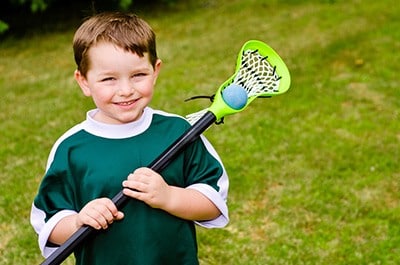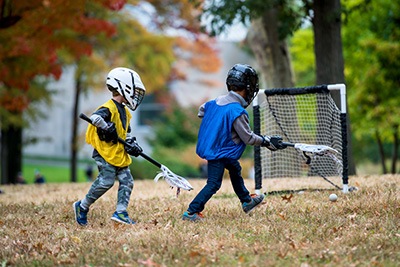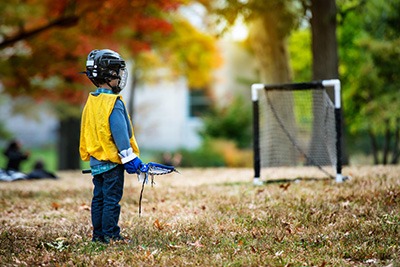Are you looking to improve your game and become a better lacrosse player? Whether you're a rookie or a child, mastering the basics is essential for success.
This guide will provide the best advice and techniques on how to practice for lacrosse so that even beginners know where to start. So, if you're ready to improve your skills, let's start becoming better players today!
More...
- kiddos and rookies can play lacrosse with much practice, hard work, and dedication
- the game offers excellent tips to learn and improve your skills
- players can practice lacrosse drills at home, even without sticks, to master the abilities
- experts can create a funny and exciting atmosphere for fans and future athletes
Best Lacrosse Training for Beginners
If you're unsure whether you can become a successful lacrosse player, refer to the tactics and tips below to improve your lacrosse skills. Let's start.
Below you can find some of the best lacrosse practice tips for beginners. Ensure you read them thoroughly to find the most suitable training types.
1. Lacrosse catching drills
Some of the most popular lacrosse drills include:
- Basic passing and catching with a stationary partner - it's a great practice of right and left hands for passing and catching.
- Practicing catching goalie clears - the training includes an expert acting as a goalie and young players breaking out right or left from the goal. Players must catch the ball on the run.
- Cross-handed drills - suitable for kids and older beginners. Ensure older players practice these skills with their left hands.
- Wall-ball and rebounder skills - these drills are the most convenient for beginning lacrosse players. The drills are the fastest way to help rookies improve their catching skills, as they can practice at home by themselves or get more touches in a set period. They do not need a training partner or a team practice.
2. Lacrosse cradling drills
Some of the most prominent lacrosse skills for beginners include the following:
- Two-hand cradling - practicing two-hand cradling while running down the field. Switching from left to right side on each whistle blow from a parent or a coach.
- One-hand cradling - these drills are a bit more complex than the two-hand cradling drills. The skills include running down the field, and the player must switch hands with each whistle-blow from a parent or a coach. Experts must remind beginner lacrosse players to lock their non-cradling arms in place. Thus, they will avoid penalties.
3. Lacrosse shooting drills
The most popular lacrosse shooting drills for beginners include the following:
- Having your players - the skills include running, dodging (a real or an imaginary defender), and shooting on the goal. Players should practice left and right shots. In addition, the basic shooting drills consist of dodging and shooting from the wings and the top.
- Running, catching a pass (from a coach or a parent), and shooting - the drills require practicing both the left and right side.
- Running, scooping up the ground ball, and shooting.
- Running back from X (the back of a goal) and shooting - the skills require doing both sides - right and left.
- Running, fake shots and shooting - players must practice both sides - left and right.
- Adding targets - such as cones in the net, to practice shooting accuracy better.
- Cutting drills – a player must "cut" across the face of the goal (left to right or right to left). He should start from fifteen-twenty yards out, then run diagonally across the face of the net, and end up at the extended goal line on the other side. The coach (or another player) stands behind or near the extended goal line on the opposite side of the net (opposing to where the player starts) and feeds the player as he cuts across the goal. Players should catch and shoot on the run.
- Practice quick stick shots close to the goal.
4. Lacrosse defense drills
Here you find the essential skills for the best defense:
- Practice various checks (lift checks, poke checks, slap checks, etc.) to dislodge the ball from your opponent.
- Moving feet and screening an opponent off from the goal - an attacker tries to blow past the defender to score. On the other hand, the defender must stop a clear shot just by moving his body.
- Working on clears - a defender often wins a ground ball or snags a pass near the goal. Players must practice getting rid of the ball quickly, especially to a midfielder, to start a fast break.
- Defense long poles - starting around the fifth or sixth grade, defenders can use lacrosse defense long poles. Snagging high passes by your opponents is an advantage the long pole offers. The defender gains the ball for the team and infuriates the opposing coach!
- Wall ball drills - the player must throw high passes against a wall. Then, he should try to snag the high rebounds with the fully extended d-pole.
- Practice checks - some checks might be easier with a long defensive pole (wrap check).
- Protecting the ball drills - Protecting the ball is more challenging as the long pole might stick out above the player's head. You should apply long pole cradling and specific "under pressure" drills (attackers riding the defensive players).
5. Lacrosse dodging drills
Below are some of the best full-speed dodging drills for regular practice:
- Practice dodging past a defender with various dodges (roll, split, face dodge, etc.) - the player starts without pressure from the defender and slowly increases to full-pressure defense.
- Combine with shooting drills - players must dodge past a defender to shoot at the goal. The defender either goes all out or gives the light poke checks for players to focus more on specific dodging mechanics.
6. Lacrosse ground balls drills
Ground ball drills are essential for training skills to test your body strength and speed and focus better on the ball. Here are the most popular drills:
- Roll-ball out, and two players charge out to win the ball - the winner should then try to shoot a goal. The loser defends against this shot. Coaches/parents may make it harder with three players going after one ball.
- Practice scooping ground balls - players practice stick skills without pressure from various angles. They might roll the balls quickly toward the players in the front as they run toward you. Experts may have the players scoop the balls from the side as they run across the field.
- Drop a ball halfway between the two players - you should let them "fight" for the ball.
- Box-out drill - a player uses his hips, rear, etc., to push his opponent away from the ball.
- Kicking the ball out of the scrum - players gain possession by kicking a contested ball away from the opposing team to get a quicker pick-up.
- Ground ball drill & "reaction speed" - the players should face away from the coach/parent and turn to scoop up the ground ball when an expert requires them to turn as they roll out the ball.
7. Lacrosse passing drills
Teammates must have excellent defense skills and develop passing requirements, as cooperation is crucial for teams to win. So, here are some of the best passing drills for regular practice.
- Primary passing and catching with a stationary partner – helps fans practice their right and left-hand catches and passes. This is one of the first beginner lacrosse drills that children/rookies should practice. The training partner can be another child/older player or a parent.
- Two children parallelly run down the field, passing balls back and forth.
- Passing under pressure - one child lightly pressures a passer who must get off a clean pass to the coach/parent.
- Triangle drill - requires three children in a triangle passing around the triangle. The skill starts with ten righty passes and catches and switches to ten lefties. Experts might make it harder by requesting the children to run in a circle while passing and catching the balls.
- Bad pass drills - children throw unpredictable passes in a lacrosse game. Young players must practice catching such passes. Two children should face each other and make bad passes to each other (throw the ball high, pass low, throw the ball to the left side when the teammate has the stick on the right side, and similar passes).
8. Lacrosse clearing drills
The clearing drills are ideal lacrosse skills for helping players learn how t successfully catch clears on the run. It also helps them keep the ball away from the goalie.
- Clearing drill - the basic requirements involve defenders & midfielders standing in a line near the goalie. They take turns running toward the midfield line. The first player runs to the right side, and the goalie passes the ball to him. The second player in the line runs toward the middle of the field, and the goalie passes the ball to him. The third player runs left, and the goalie passes the ball, etc. The clearing drill teaches young players to catch clears on the run.
- Adding a player & making the drill sensible - once players can catch clears well, experts can include a player (offense) to ride the clearing player after they catch the ball.
- Crosse field passes - players practice the drills after receiving a clear. They might have to clear the ball by passing to an open teammate on one end or another of the field.
9. Lacrosse riding drills
Lacrosse riding drills are a critical skill for each lacrosse player. An offensive lacrosse player must master the legal ride to prevent slashing penalties, etc.
In addition, a defensive lacrosse player must practice against rides to develop a higher chance of successful clears.
A riding game drill helps you get the ball back for your team (if an opposing goalie tries to initiate a clear), slow, or stop a potential fast break against your team.
10. Lacrosse wall ball drills
Amateurs should practice a wall ball drill the most, for these are the most effective way to improve amateurish stick skills. Some of the best exercises include:
- Non-dominant hand game drill - players should practice passing and catching with their non-dominant hands. Coaches will be thrilled if players use both hands effectively.
- Tennis balls for wall ball - sometimes, children are afraid of the heavier lacrosse ball since it might hurt them if/when they get struck by a missed rebound. However, a lightweight tennis ball is similar in size and causes less pain if it hits potential players.
- Use the wall for advanced players - let them pass with their right hand and catch with their left (and vice versa), stimulate fakes, catch one hand cross-handed, use the ball for throwing behind-the-back shots and passes, etc.
11. Lacrosse speed & agility drills
These training drills are ideal for a begging lacrosse player, children, and more advanced players (they can increase the speed rate & improve their flexibility).
In addition, advanced stick skills are necessary for the best performance. Let's see the critical exercises:

- Timed forty-yard dashes – children should run in full gear while cradling a ball. They should automatically lose the race if they drop the ball! It might cause extra fun but also adds more pressure for children to endure.
- Suicide drills – these increase the speed rate. Players must sprint to the ten-yard line and touch it. Then, they should sprint back to the zero-yard line and touch it. Again, they sprint to the twenty-yard line and touch it, then sprint to the zero-yard line & touch it. The process continues to help rookies quickly change directions and increase their speed.
- Sideways shuffle drills – improve defense lacrosse player to move and screen off an opponent from the goal. Lacrosse experts can set out two cones and make children shuffle sideways without crossing their feet between the two cones. The training sessions help children with lateral movement.
- Backward drills – are valuable for defense and midfield players staying in front of an attacking opponent. The drills work on their ability to move back quickly without falling. The drills are the same as the suicide drills, just going back.
- Zigzag drills – the main s focus is on improving the ability to make quick direction changes when running fast. It's valuable for all offensive players, especially the midfielder position. Lacrosse experts can place six-to-eight cones in a staggered zigzag pattern down the lacrosse field. Each player needs to sprint to the first cone, cut left to the second cone, cut right to the third cone, and so on.
- Agility ladder drills – are excellent for increasing footwork, quickness, and speed. Some experts praise the exercises, while others aren't that thrilled.
Best Fun Youth Lacrosse Drills for Kids
Lacrosse drills are not suitable only for older players but children as well. Some fun lacrosse drills ideal for children are listed above since all amateurs can practice them.
In addition, below, you can find fun lacrosse activities for the youngest to help them improve their overall performance.
- Station orange cones - children demonstrate a different dodge at each cone.
- Two kiddos running down the field in parallel, passing back and forth - running and catching with a non-dominant hand might be challenging for beginners.
- Ground ball drill - experts roll out the ball and show the children how to get low and scoop up the ball.
- Basic dodging drills - they must dodge past a lacrosse expert. The fundamental lacrosse dodges include the face, split and roll dodge.
- Cradling drills - running a short distance without dropping the ball.
- Easy passes to improve catching
- Shooting fundamentals & practices - roll out ground balls to retrieve and shoot on the goal.
- Work on the basics, making it fun for the youth due to the limited attention span of younger children.
- Use lacrosse sharks, minnows, chickens, and similar games - for shooting and making the game more interesting.
- Use high-rep sessions and apply harder conditions - as their coordination and attention improve - the team will gain muscle memory and decide faster while in the game.
Extra Lacrosse Practice Tips for Beginners and Children
Here are some of the crucial additional lacrosse activities for beginners to adapt to the game quickly:
- Create dynamic lacrosse practice plans: Plan according to your needs and skills. Organize for the best results, and use the free time to practice the required abilities to advance in a shorter time.
- Practice throwing and catching to improve your lacrosse stick skills: Play like a ball is an egg. Focus on it, and hold the sticks to prevent the ball from popping out.
- Face the other team as you receive a pass: Ensure you know the ball's location as you face the passer and his team members. Do not lose focus, and keep your head on the game.
- Keep the game simple: Play short and sharp passes, and hold the stick correctly. If you lose the ball, pass it quickly to prevent the opponent defender from taking it.
- Communication: Talk to your members about a strategy to compete better and win. Don't be shy or silent; otherwise, you won't play well.
FAQs
What are the 3 skills needed to play lacrosse?
The three needed skills include catching, cradling, and scooping.
How can I improve my lacrosse fast?
You can improve fast by practicing the given drill types. The alternatives include:
- learning the positions better
- more playing and practice
- watching various videos and movies for overall comprehension
- getting faster footwork
- mastering ground balls
- improving wall ball routines
- improving dodging
- practicing
box lacrosse
- off-season training sessions
- reviewing defense tips
How do I get fit for lacrosse?
You can try various exercises, such as:
- rope jumping
- the plank
- ladder exercises
- ab workout
- pushups
- yoga and stretching, and similar exercises.
How to practice lacrosse without a stick?
You can practice your hands, speed, footwork, agility, and hips first and do multiple exercises to improve your body skills.
What do you wear for lacrosse practice?
You should wear a chest protector, arm, leg, shoulder pads, helmets, mouthguards, and shinguards (for girls and high school players).
How to practice for lacrosse tryouts?
Here are some of the best exercises to help you to practice for tryouts:
- Warm up & stretching
- Passing-line drill
- Ground ball drill
- Four vs. Three fast-break drill
- One vs. One dodging drill
- Wall ball test
- Scrimmages
- Conditioning
Where to practice lacrosse near me?
You can look for various organizations, camps, leagues, etc., near you. You can find more information here.
Did You Learn the Best Lacrosse Beginner Drills?
Hopefully, you know the best drill types for rookies and kids and can start your lacrosse journey effortlessly. Always focus on your speed, agility, and physical strength to improve faster.
And always keep your head in the game for the best outcome!



